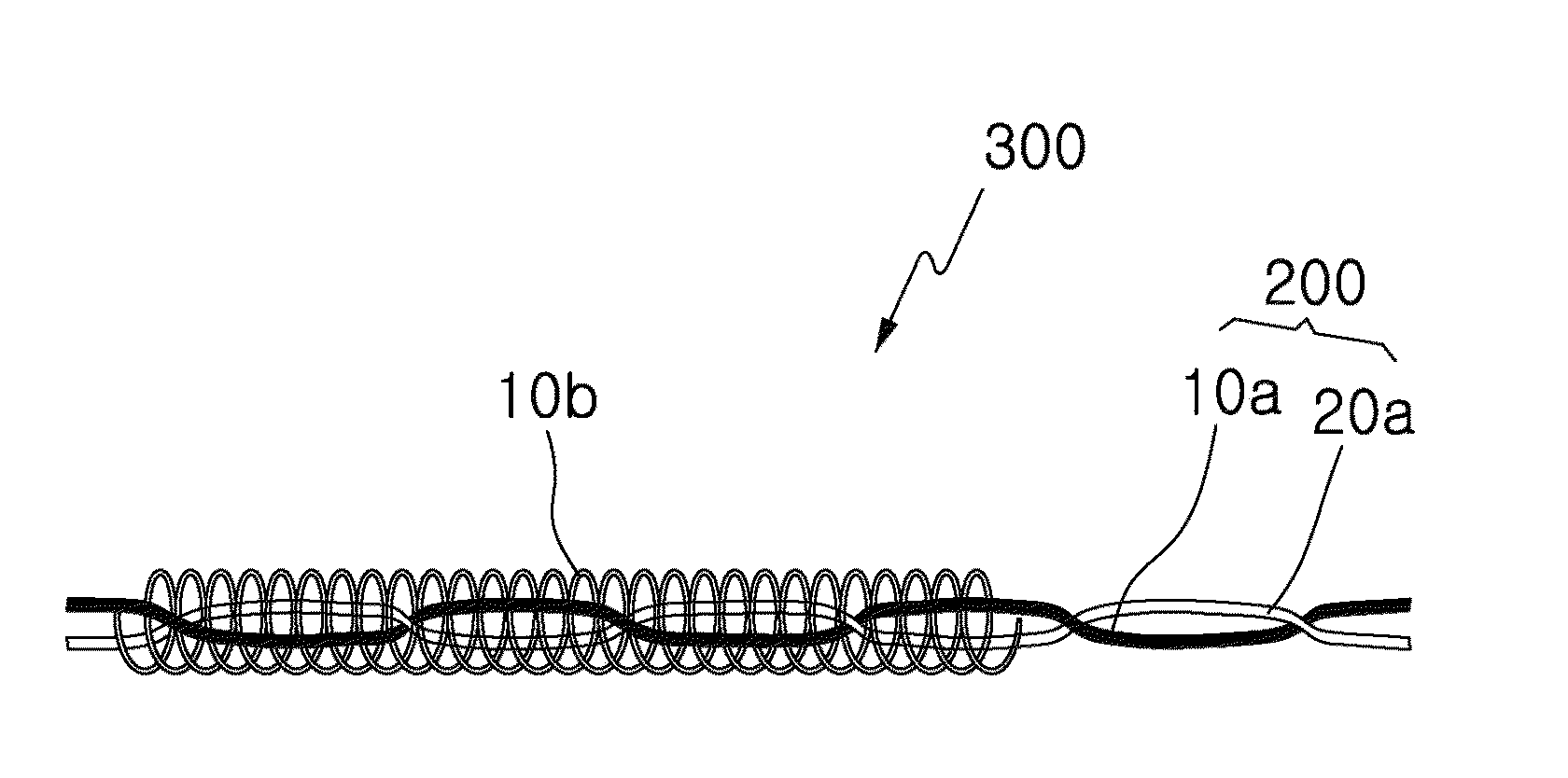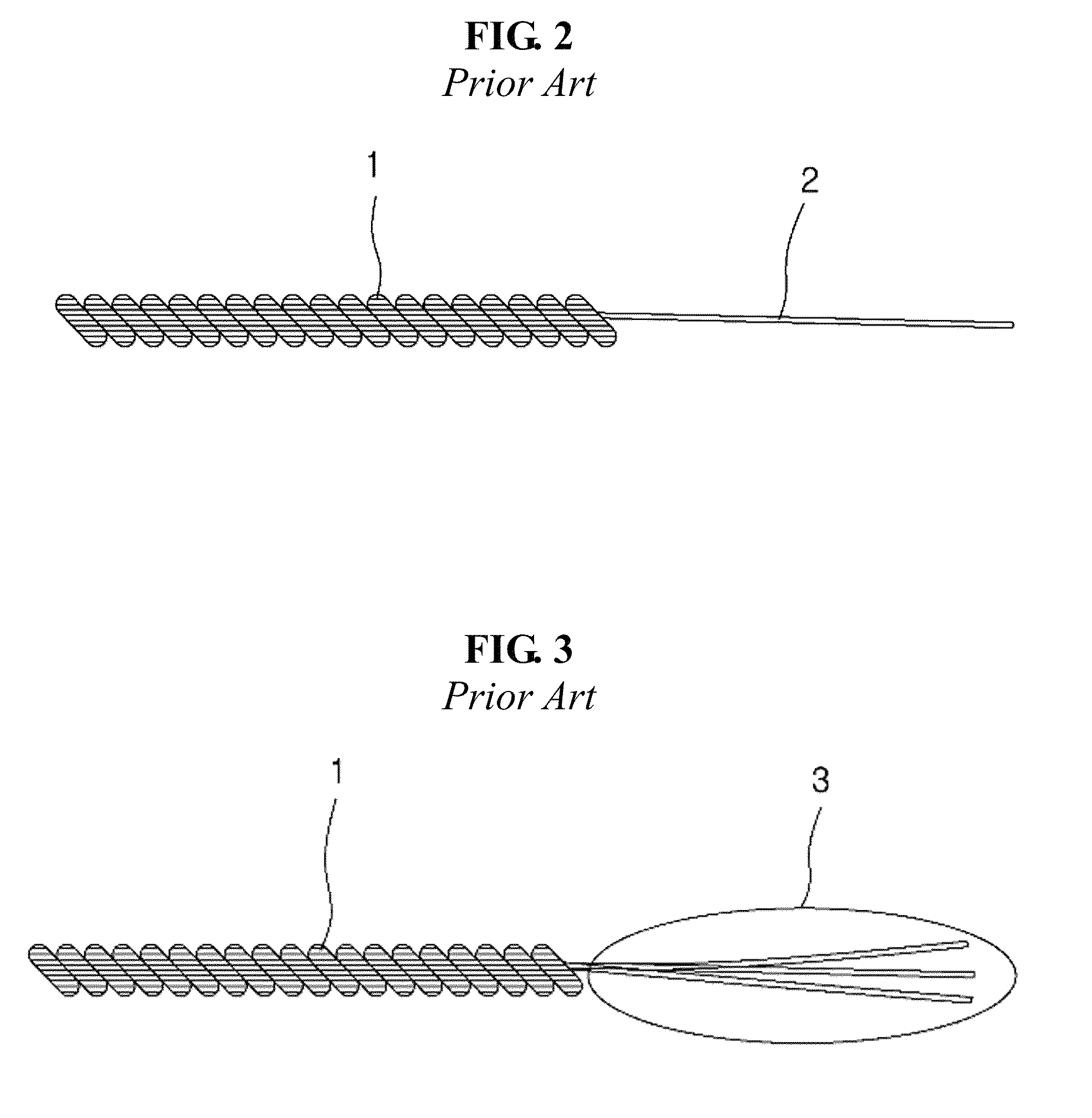Silver yarn, plied yarn silver yarn, functional fabric using same, and method for producing same
a technology of silver yarn and silver yarn, which is applied in the direction of knitting, thin material processing, textiles and papermaking, etc., can solve the problems of difficulty in evenly dispersing silver particles to the thread, deterioration in efficiency, and thread breakage, and achieves the effect of permanent antibacterial effect and conductivity, and high effective in preventing electromagnetic waves and static electricity
- Summary
- Abstract
- Description
- Claims
- Application Information
AI Technical Summary
Benefits of technology
Problems solved by technology
Method used
Image
Examples
embodiment 1
[0084]Pure silver (Ag) was melted using a horizontal continuous casting machine with a heated mold, and a rod with a diameter of 9 mm having a one-way structure was casted. The casted rod was made into a silver wire with a diameter of 40 μm through a sequential pulling work in a rod break-down drawing machine, a medium wire drawing machine, a wire drawing machine, and a fine wire drawing machine. A plied yarn was produced by mixing the silver wire, traditional Korean paper and PLY, which is a fiber made of cornstarch. First, one strand of 120 denier silver wire (20 denier in appearance) and one strand of 177 denier traditional Korean paper were twisted into 350T / M. The produced plied yarn was covered with two strands of 75 denier PLA, which was fiber made from cornstarch, so that 347 denier plied yarn was finally produced. The plied yarn was finally dyed with navy color through a dyeing process.
embodiment 2
[0085]Like the first embodiment of the present invention, pure silver (Ag) was melted using a horizontal continuous casting machine with a heated mold, and a rod with a diameter of 9 mm having a one-way structure was casted. The casted rod was made into a silver wire with a diameter of 40 μm through a sequential pulling work in a rod break-down drawing machine, a medium wire drawing machine, a wire drawing machine, and a fine wire drawing machine. A plied yarn was produced by mixing the silver wire, traditional Korean paper and PLY, which is a fiber made of cornstarch. First, one strand of 120 denier silver wire (20 denier in appearance) and one strand of 177 denier traditional Korean paper were twisted into 350T / M. The produced plied yarn was covered with one strand of 75 denier PLA, which was fiber made from cornstarch, and on strand of 89 denier cotton so that 361 denier plied yarn was finally produced. The plied yarn was finally dyed through a dyeing process.
embodiment 3
[0086]A fabric was made by knitting the plied yarns produced through the first and second embodiments using a 12-gauge knitting machine (circular knitting machine) in case of 1 ply yarn and using a 7-gauge knitting machine in case of 2 ply yarn. FIG. 10 shows the fabric obtained through the third embodiment of the present invention.
[0087](Anti-Bacterial Test)
[0088]As a result of test on the anti-bacterial function of a specimen obtain through the third embodiment using staphylococcus aureus ATCC 6538 (pyogenic bacteria) as test bacteria (Test method: KS K 0693), when the fiber obtained through the third embodiment was added to a culture medium after a lapse of 18 hours from the time that the bacteria was inoculated to the culture medium, a decrease percent of the number of bacteria was more than 99.9%.
[0089](Conductivity Test)
[0090]The plied yarns produced through the first and second embodiments were tested in conductivity. In order to test conductivity, INSTEK GOM-802 (Resistance ...
PUM
| Property | Measurement | Unit |
|---|---|---|
| diameter | aaaaa | aaaaa |
| diameters | aaaaa | aaaaa |
| diameter | aaaaa | aaaaa |
Abstract
Description
Claims
Application Information
 Login to View More
Login to View More - R&D
- Intellectual Property
- Life Sciences
- Materials
- Tech Scout
- Unparalleled Data Quality
- Higher Quality Content
- 60% Fewer Hallucinations
Browse by: Latest US Patents, China's latest patents, Technical Efficacy Thesaurus, Application Domain, Technology Topic, Popular Technical Reports.
© 2025 PatSnap. All rights reserved.Legal|Privacy policy|Modern Slavery Act Transparency Statement|Sitemap|About US| Contact US: help@patsnap.com



